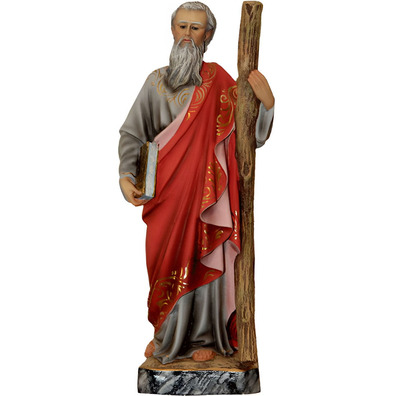Saint Andrew, the brother of Saint Peter
269,00€
Taxes includedReligious product available on request . Shipping time is approximately 6-10 weeks. For more information about this product, contact to Brabander catholic products.
Image of Saint Andrew
- Piece of religious imagery of Saint Andrew.
- For sale in three sizes 20, 30 and 40 cm.
- Made of pulp wood.
- Pedestal imitating marble
- Eyes made of glass to enhance the nobility of the figure.
- Vestments decorated in gold color.
Saint Andrew, the brother of Saint Peter
On November 30, both the Catholic Church and the Orthodox Church celebrate Saint Andrew's Day.
Saint Andrew, also known as Saint Andrew the Apostle, was a very important figure for Jesus. Saint Andrew is considered the first disciple of Jesus.
Saint Andrew is the older brother of Saint Peter. Both were born in the town of Bethsaida. Saint Andrew and Saint Peter earned their living as fishermen until they received the call from Jesus.
Saint Andrew was chosen to be one of the twelve Apostles who accompanied Jesus. He witnessed the great miracles of Jesus, such as the miracle of the loaves and fishes, and participated in the great moments of Jesus' life, such as the Last Supper.
After the death of Jesus Christ, Saint Andrew dedicated his life to preaching and spreading the word of his Master. There are numerous writings that speak of different places through which Saint Andrew traveled proclaiming the Word of the Lord. The places he visited are not known for sure. What we do know is that Saint Andrew was in Byzantium, also known as Constantinople, current Estabul, a city in which he founded the Orthodox Church of Constantinople, naming Saint Stachys as the first Bishop.
After a long life, Saint Andrew was crucified on November 30, 60 AD. C. in Achaia, Greece, during the reign of Nero.
The Cross of Saint Andrew
Saint Andrew was crucified on November 30, 60 AD. C. Saint Andrew was martyred and suffered painful agony on the Cross, as Jesus had already done.
The Cross on which Saint Andrew died was in the shape of an “X”. The Saint, instead of being nailed to the Cross like Jesus, was tied, since his executioners wanted to increase the hours of pain and suffering.
The Crosses with the shape of an "X" from that moment on are known as Cruz de San Andrés or Cruz aspada.
Saint Andrew, religious imagery from the Olot workshops
The piece of religious imagery of Saint Andrew has been manufactured following traditional processes. These manufacturing methods were established in the 19th century by the Olot imagery workshops, and are known worldwide.
Pulp wood is the material with which the imagery works of the Olot workshops are made. It is a material that allows realistic and extremely light finishes.



